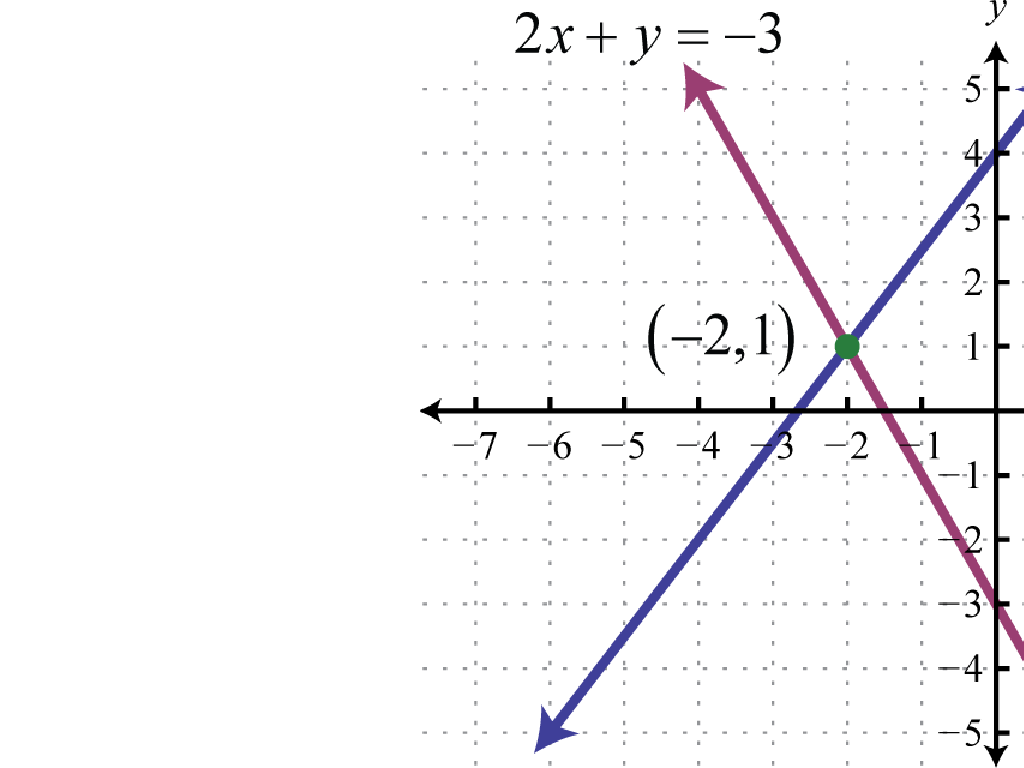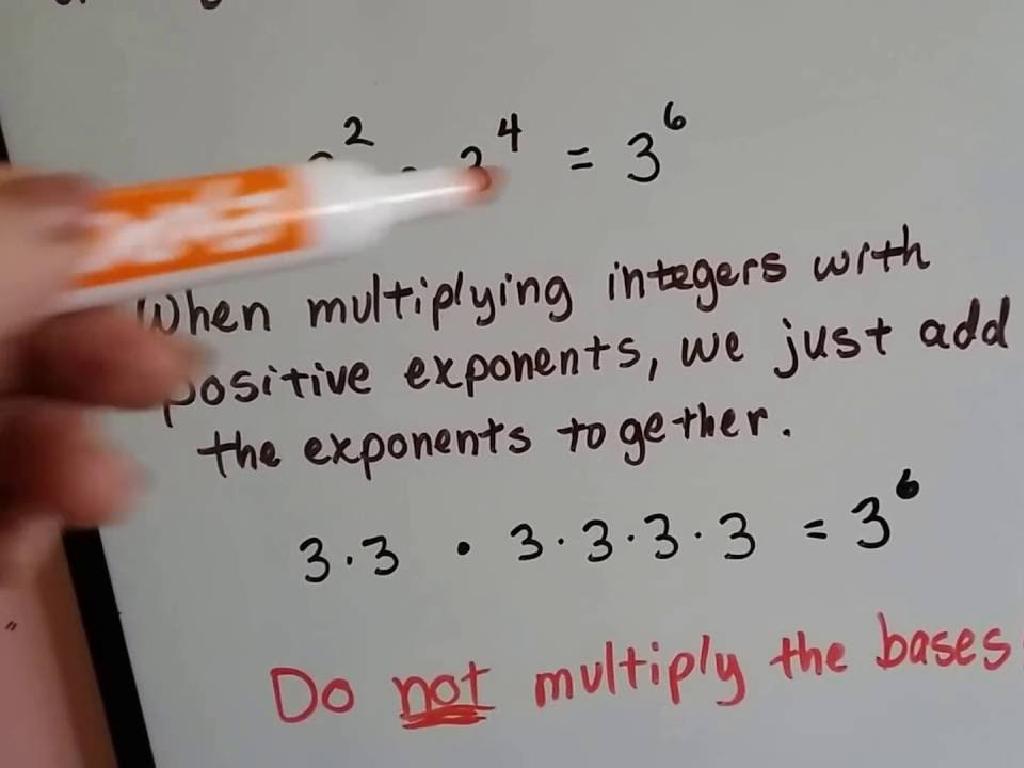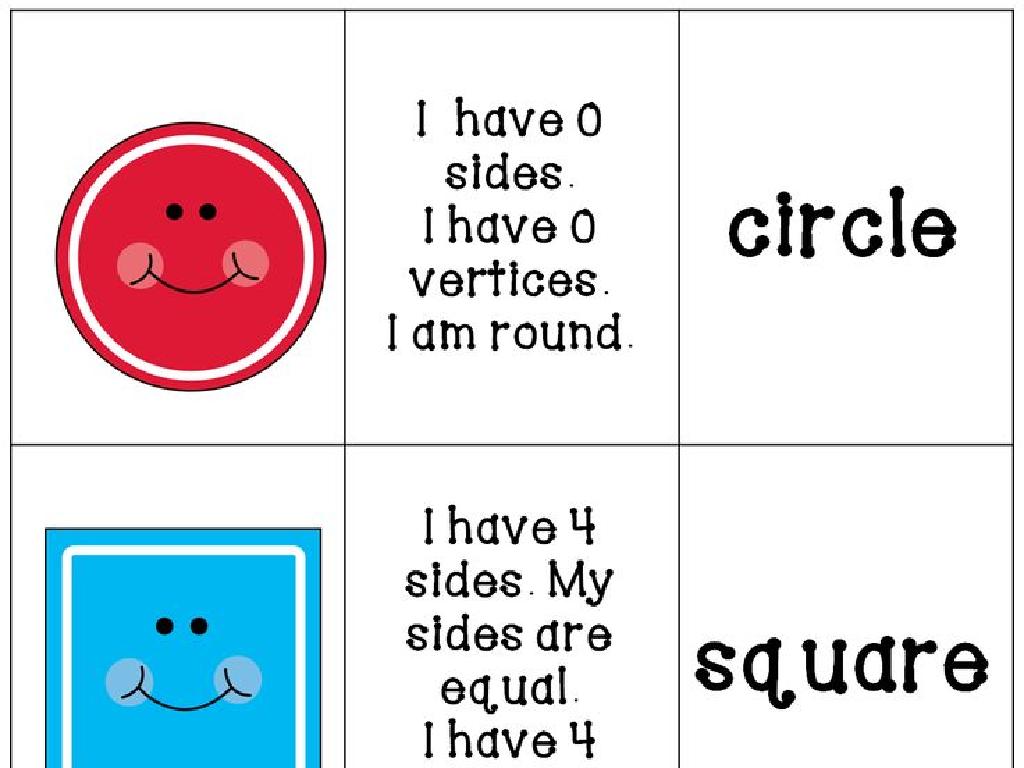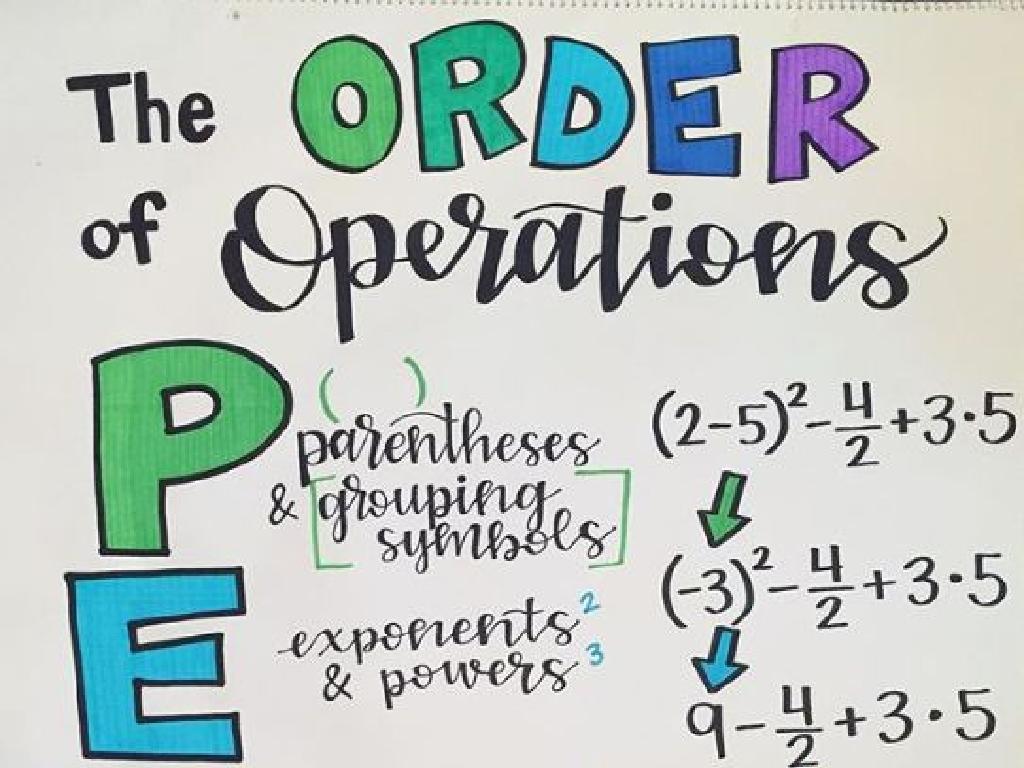Identify Factors
Subject: Math
Grade: Fourth grade
Topic: Factors And Multiples
Please LOG IN to download the presentation. Access is available to registered users only.
View More Content
Welcome to Factors!
– Discovering what factors are
– Factors are numbers we can multiply together to get another number
– Importance of factors in math
– They help us understand numbers better and solve various math problems
– Reviewing multiplication basics
– Let’s recall how to multiply numbers to find products
– Engaging with factor examples
– For example, factors of 6 are 1, 2, 3, and 6 because 1×6=6 and 2×3=6
|
Begin the lesson by explaining that factors are the building blocks of multiplication and division. They are essential for understanding how numbers are composed and for solving problems involving fractions, greatest common factors, and least common multiples. Review multiplication basics to ensure students are comfortable with the concept of multiplying numbers to find a product. Use simple and relatable examples, such as finding all the factor pairs of a number like 6, to illustrate the concept. Encourage students to participate by identifying factors of different numbers and understanding that a factor is a number that divides another number without leaving a remainder.
Understanding Factors
– Definition of factors
– Numbers that multiply to give another number
– Every number’s factors
– At least two: 1 and the number itself
– Example: Factors of 6
– 1, 2, 3, 6 because 1×6=6 and 2×3=6
|
Begin the lesson by explaining that factors are the building blocks of multiplication. They are the numbers we multiply together to get another number. Emphasize that every number has at least two factors, which are 1 and the number itself. Use 6 as an example to show that 1 and 6 are factors because they multiply to make 6, as do 2 and 3. Encourage students to think of factors as pairs of numbers that work together to create a product. To reinforce the concept, you can have students list factors of different numbers, use factor trees, or find factors through division.
Finding Factors of a Number
– Start with 1 and the number
– Every number has 1 and itself as factors
– Find pairs that multiply
– Look for two numbers that when multiplied give the original number, like 2 x 3 for 6
– Use a factor tree
– Draw a tree to break down a number into its prime factors
– Try division to find factors
– Divide the number by 1, 2, 3, etc., to see if there’s no remainder
|
When teaching fourth graders to find factors, start by explaining that a factor is a number that divides into another number without leaving a remainder. Demonstrate that every number’s factors include 1 and the number itself. Show how to find all factor pairs by starting with the smallest numbers and working up, ensuring that students understand the concept of multiplication in this context. Introduce the factor tree as a visual aid to break down numbers into their prime factors. Also, teach them how to use division to check for factors systematically. Provide several examples and encourage students to work through them to solidify their understanding.
Exploring Factor Pairs
– What are factor pairs?
– Two numbers that multiply to give a target number
– Example: Factor pairs of 12
– (1, 12), (2, 6), and (3, 4) are factor pairs of 12
– Factors repeat in reverse
– After a certain point, factors are the ones we found before, but flipped
– Finding factors is like a puzzle
|
This slide introduces the concept of factor pairs to fourth-grade students. Begin by explaining that factor pairs are two numbers that, when multiplied together, result in the target number. Use 12 as an example to show the factor pairs and highlight how, after reaching the middle factor, the pairs start to repeat in reverse order. This can be likened to solving a puzzle where students need to find all the pieces (factors) that fit together perfectly to make the target number (the completed puzzle). Encourage students to practice with different numbers to become comfortable with identifying factor pairs.
Practice Time: Finding Factors of 8
– Let’s explore factors of 8
– Discover factor pairs together
– Factor pairs for 8: (1, 8) and (2, 4)
– Factors are <= the number
– Practice finding factors
– Use multiplication to find factors
|
This slide is designed for an interactive class activity where students will practice identifying factors of the number 8. Begin by explaining that factors are numbers that can be multiplied together to get another number. Then, guide the students to find all the factor pairs of 8 by using multiplication facts they already know. Remind them that a factor must be less than or equal to the number itself. For the activity, students can work individually or in pairs to list the factors of 8 and check each other’s work. Encourage them to use multiplication to verify if their factor pairs are correct. This exercise will help solidify their understanding of factors and prepare them for finding factors of larger numbers.
Factors in the Real World
– Factors solve real problems
– Example: Grouping items equally
– Like sharing 12 cupcakes with 4 friends, each gets 3
– Factors simplify multiplication
– Knowing factors of 12 helps multiply faster
– Factors simplify division
– Dividing 12 by its factors gives whole numbers
|
This slide aims to show students how understanding factors is not just a mathematical concept but a practical tool for everyday problem-solving. Factors are the numbers we multiply together to get another number. For instance, when arranging a party, if we have 12 cupcakes and want to divide them equally among 4 friends, knowing that 4 is a factor of 12 helps us quickly see that each friend gets 3 cupcakes. Similarly, understanding factors can make multiplication and division tasks much easier, as it helps in breaking down numbers into more manageable parts. Encourage students to think of other real-world scenarios where knowing factors would be useful. This will help them see the value of what they’re learning beyond the classroom.
Class Activity: Factor Hunt
– Find objects with factors of 24
– Work in pairs to list factors
– List all numbers that multiply to give 24
– Discuss your factor-finding strategy
– How did you determine if a number is a factor of 24?
– Understand what makes a number a factor
– A factor is a number that divides 24 with no remainder
|
This interactive activity is designed to help students identify factors in a fun and engaging way. By searching for objects in pairs, students will apply their understanding of factors to real-world contexts. The teacher should facilitate the activity by ensuring students understand that a factor is a number that divides into another number without leaving a remainder. After the hunt, lead a discussion to reflect on the strategies used to identify factors. Possible activities: 1) Counting items in the classroom, 2) Using multiplication tables, 3) Creating factor trees, 4) Drawing arrays to visualize the factors, 5) Using division to test if numbers are factors of 24. This will help students grasp the concept of factors and how to find them.
Conclusion & Reflection: The Role of Factors
– Congratulations on learning factors!
– Understanding the importance of factors
– Factors are building blocks in math, like for multiplication and division
– Factors in math and everyday life
– Factors help in problem-solving, like arranging objects or sharing equally
– Identifying factors in various situations
– Think of times you share things or group items – that’s using factors!
|
Well done to all the students for their hard work in identifying factors! Factors are not just a mathematical concept but also a practical tool used in everyday life. They are essential for understanding multiplication and division, and they play a significant role in problem-solving. For example, when dividing a set of items into equal groups or arranging objects, we are using factors. Encourage students to reflect on the importance of factors and to think of other real-life situations where they might use this concept. Ask them to share examples from their experiences, such as sharing snacks with friends or organizing their toys, to reinforce their understanding of the topic.





